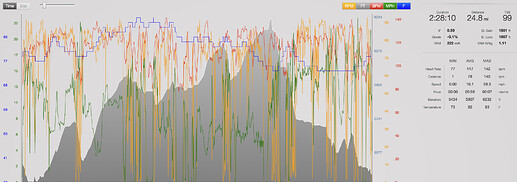Hey Steve,
thanks for sharing. Wow, that’s some elevation gain. I’m from PA originally, so know what you’re talking about with old school trails - super fun, but not great for trying to keep HR under control!
So this is a scenario where I always want to step back and think of the big picture. It’s winter, and if we don’t have any events coming up right away, I feel that maintaining some flexibility and fun is crucial. Could this ride have been executed more “cleanly”? Sure, but at this time you were able to enjoy a MTB ride while maintaining the focus on the goal - you stayed in your endurance zone, felt at the end like you could keep riding, and are good to go for today’s strength session. If you did this for every single endurance ride, that might be a little too much variability to include all the time, but to bring balance to your riding, I think this is a great option.
Personally, I would not consider this too hard if your overall effort was in zone 1 (of 3), with the caveat above of finding that balance of enjoyment and more highly structured rides. I’ll do a similar approach. Some days just need to be on the trail because it’s an enjoyment factor, and it also has the added benefit of developing the feel of riding easier while on trail. This comes in handy when racing as you can focus on recovery and smooth riding in a higher stress scenario with other racers around. In contrast, I’ll balance this with days where I’ll take the MTB or road bike out on dirt roads and achieve a better looking HR graph.
To your question of managing coasting/downhill parts of the ride, I’ll go with the annoying “it depends” answer. With the frequency of grade changes you likely have in your terrain there, it can be hard to manage, almost to the point where we get stressed out a bit by trying to micro-manage the effort, thus the VI. I do like how @trevor calls those LSD rides L “Steady” D rather than slow. So in your case with the coasting/downhill segments, I’ll try to plan my effort based on the descent coming up. If it’s technical, I know HR will remain somewhat elevated even though I might be coasting and just absorbing bumps. If not, and it’s more of a pedaling descent, I’ll try to continue pedaling. Coming into those descents though, I may push a little higher in my base range, nearing the upper end (tempo-ish) because I know that HR will peak and then start to decline, but I’ll likely be at the base of the descent before it dips too low for too long. Otherwise, if that’s a problem and the descents are too long, it may be necessary for a change of terrain to better accommodate those needs.
Great questions and feedback. I think the way you’re approaching this is excellent. Just keep in mind that balance, and the big picture. That way you can enjoy the riding and not become a slave to the data.
Coach Ryan

